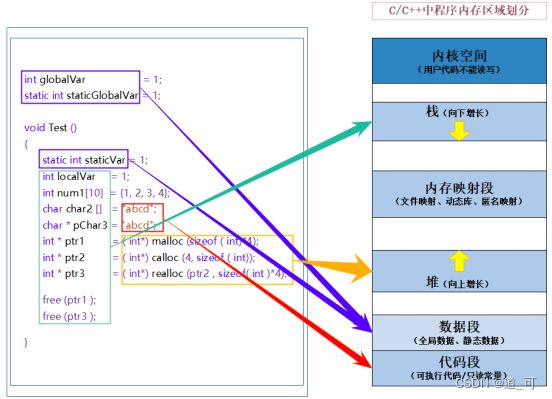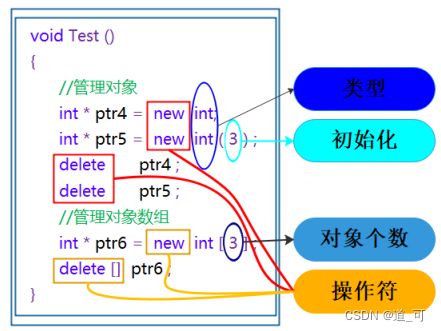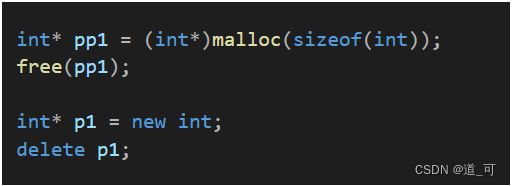c++中的动态内存管理
目录
1.内存分布
2.c语言动态内存管理
3.c++动态内存管理
4.operator new 与operator delete 函数
5.定位new
6.malloc/free 与 new/delete 的区别
1.内存分布
首先我们需要了解一下数据在内存中的分布,请看以下代码:
int globalVar = 1;
static int staticGlobalVar = 1;
void Test()
{
static int staticVar = 1;
int localVar = 1;
int num1[10] = { 1, 2, 3, 4 };
char char2[] = "abcd";
const char* pChar3 = "abcd";
int* ptr1 = (int*)malloc(sizeof(int) * 4);
int* ptr2 = (int*)calloc(4, sizeof(int));
int* ptr3 = (int*)realloc(ptr2, sizeof(int) * 4);
free(ptr1);
free(ptr3);
} 【说明】
- 1. 栈又叫堆栈--非静态局部变量/函数参数/返回值等等,栈是向下增长的。
- 2. 内存映射段是高效的I/O映射方式,用于装载一个共享的动态内存库。用户可使用系统接口创建共享共享内存,做进程间通信。(Linux课程如果没学到这块,现在只需要了解一下)
- 3. 堆用于程序运行时动态内存分配,堆是可以上增长的。
- 4. 数据段--存储全局数据和静态数据。
- 5. 代码段--可执行的代码/只读常量。
2.c语言动态内存管理
c语言动态内存管理:
malloc / calloc / realloc / free :详情可参考c语言动态内存管理函数
面试题:
1. malloc/calloc/realloc 的区别?
答:malloc 与 calloc 都是申请内存空间,只不过calloc 会对空间进行初始化,而 realloc 是对已有空间进行扩展。
3.c++动态内存管理
C 语言内存管理方式在 C++ 中可以继续使用,但有些地方就无能为力,而且使用起来比较麻烦,因此C++ 又提出了自己的内存管理方式: 通过 new 和 delete 操作符进行动态内存管理 。
- new/delete操作内置类型
void Test()
{
// 动态申请一个int类型的空间
int* ptr4 = new int;
// 动态申请一个int类型的空间并初始化为10
int* ptr5 = new int(10);
// 动态申请10个int类型的空间
int* ptr6 = new int[3];
delete ptr4;
delete ptr5;
delete[] ptr6;
} 注意:申请和释放单个元素的空间,使用 new 和 delete 操作符,申请和释放连续的空间,使用 new[ ] 和 delete[ ] ,注意:匹配起来使用。
- new和delete操作自定义类型
class A
{
public:
A(int a = 0)
: _a(a)
{
cout << "A():" << this << endl;
}
~A()
{
cout << "~A():" << this << endl;
}
private:
int _a;
};
int main()
{
// new/delete 和 malloc/free最大区别是 new/delete对于【自定义类型】除了开空间还会调用构造函数和析构函数
A* p1 = (A*)malloc(sizeof(A));
A* p2 = new A(1);
free(p1);
delete p2;
// 内置类型是几乎是一样的
int* p3 = (int*)malloc(sizeof(int)); // C
int* p4 = new int;
free(p3);
delete p4;
A* p5 = (A*)malloc(sizeof(A)*10);
A* p6 = new A[10];
free(p5);
delete[] p6;
return 0;
} 注意:在申请自定义类型的空间时, new 会调用构造函数, delete 会调用析构函数,而 malloc 与 free 不会 。
4.operator new 与operator delete 函数
new 和 delete 是用户进行 动态内存申请和释放的操作符 , operator new 和 operator delete 是 系统提供的全局函数 , new 在底层调用 operator new 全局函数来申请空间, delete 在底层通过 operator delete 全局函数来释放空间。
delete 的底层是operator delete ,operator delete 是 free 的封装
new 和 delete 的实现原理
内置类型
如果申请的是内置类型的空间, new 和 malloc , delete 和 free 基本类似,不同的地方是:new/delete申请和释放的是单个元素的空间, new[] 和 delete[] 申请的是连续空间,而且 new 在申请空间失败时会抛异常,malloc 会返回 NULL 。
自定义类型
- new的原理
1. 调用 operator new 函数申请空间
2. 在申请的空间上执行构造函数,完成对象的构造
- delete的原理
1. 在空间上执行析构函数,完成对象中资源的清理工作
2. 调用 operator delete 函数释放对象的空间
- new T[N]的原理
1. 调用 operator new[] 函数,在 operator new[] 中实际调用 operator new 函数完成 N 个对象空间的申请
2. 在申请的空间上执行 N 次构造函数
- delete[]的原理
1. 在释放的对象空间上执行 N 次析构函数,完成 N 个对象中资源的清理
2. 调用 operator delete[] 释放空间,实际在 operator delete[] 中调用 operator delete 来释放空间
5.定位new
定位 new 表达式是在 已分配的原始内存空间中调用构造函数初始化一个对象 。
使用场景:
定位 new 表达式在实际中一般是配合内存池使用。因为内存池分配出的内存没有初始化,所以如果是自定义类型的对象,需要使用new 的定义表达式进行显示调构造函数进行初始化。
class A
{
public:
A(int a = 0)
: _a(a)
{
cout << "A():" << this << endl;
}
~A()
{
cout << "~A():" << this << endl;
}
private:
int _a;
};
// 定位new/replacement new
int main()
{
// p1现在指向的只不过是与A对象相同大小的一段空间,还不能算是一个对象,因为构造函数没有执行
A* p1 = (A*)malloc(sizeof(A));
new(p1)A; // 注意:如果A类的构造函数有参数时,此处需要传参
p1->~A();
free(p1);
A* p2 = (A*)operator new(sizeof(A));
new(p2)A(10);
p2->~A();
operator delete(p2);
return 0;
}6.malloc/free 与 new/delete 的区别
malloc/free 和 new/delete 的共同点是:都是从堆上申请空间,并且需要用户手动释放。不同的地方是:
1. malloc 和 free 是函数, new 和 delete 是操作符
2. malloc 申请的空间不会初始化, new 可以初始化
3. malloc 申请空间时,需要手动计算空间大小并传递, new 只需在其后跟上空间的类型即可,如果是多个对象,[] 中指定对象个数即可
4. malloc 的返回值为 void*, 在使用时必须强转, new 不需要,因为 new 后跟的是空间的类型
5. malloc 申请空间失败时,返回的是 NULL ,因此使用时必须判空, new 不需要,但是 new 需要捕获异常
6. 申请自定义类型对象时, malloc/free只会开辟空间,不会调用构造函数与析构函数,而new在申请空间后会调用构造函数完成对象的初始化 ,delete 在释放空间前会调用析构函数完成空间中资源的清理
例:
注:概念性内容引自比特科技



